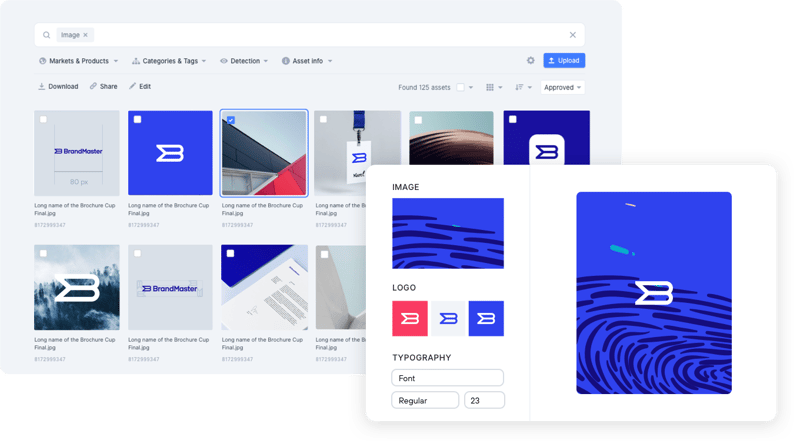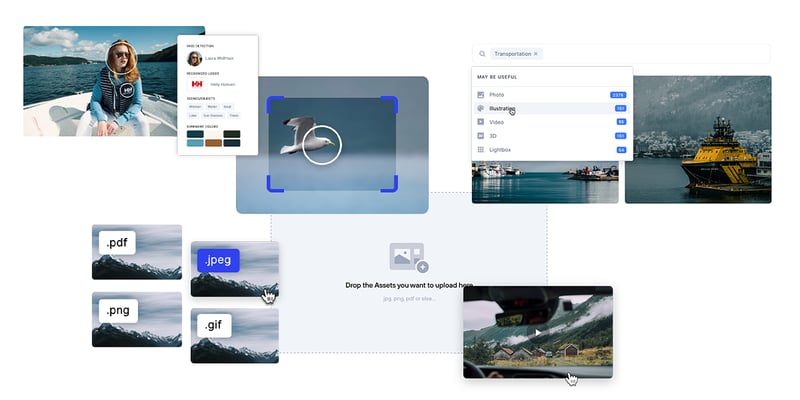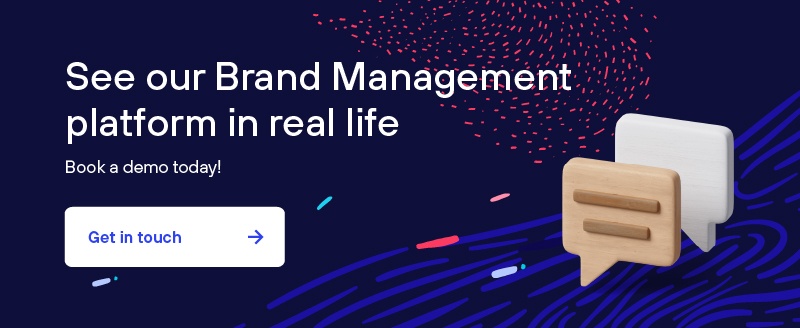Before you decide what digital asset management software to choose, you need to know current state of how your assets are managed, the challenges employees and teams are facing, how it impacts their working day and how much time and resources is spent on maintenance and creation of assets. Understanding this will help you grasp the complexity and impact of poor asset management, and it will help you through your decision-making process.
1. Map up your current asset management status
What are digital assets in your company?
Files and digital documents regardless of content is a digital asset. Created to serve a purpose for your employees and company. Images, videos, contracts, purchase orders, employee documents, presentations and sales tenders, are all assets. And rest assured, the amount of assets your company owns will only continue to rise along with the development in the paperless world we have embarked on.
Before you read further, do a quick assessment of how many digital assets your company owns and what the expected growth ratio of this pile is within the next year.
 Also read: What is digital asset management?
Also read: What is digital asset management?
Know the value of your assets
This is an important detail, and many companies disregard the meaning and value of assets. Regardless of asset purpose, time and resources has been spent on creating every asset. Not only is there a cost involved, but the assets also hold a value. Companies needs to look at this as an investment of intellectual property that it is important to protect. You need to know this value.
Understand the challenges with asset management in your company
Asset management is hard. Because assets are created by individuals, it’s not uncommon that no one has the complete overview and responsibility. When we speak with potential clients, we are often told that they have control of their assets and there is no need to improve anything. However, a closer look reveals a different story.
- Files are saved in numerous different locations: Dropbox, Adobe cloud, desktops, private folders, restricted server locations, emails, SharePoint. First, who has the complete overview of this? Second, how can you expect everyone in the company to know where to find what?
- Restricted access: With numerous files in known and unknown locations, restricted access is evident. Without access, how can you know what exists? And how can anyone else make use of the files?
- File duplications and version deviations: Because of multiple storage options, scattered saving happens. Not only does this result in file duplications, but how do you keep control of the last and final version?
What can we take from this? Poor asset management is simply bad for company efficiency and cost control.
- When you don’t know it exists you will spend time and resources recreating assets.
- When you don’t know where to look, you’ll spend vast amounts of time searching for files. Time you could have spent on more value-added work.
- When you don’t know what the last version is, the likelihood of grabbing the wrong file is huge. The damage of using wrong assets can be unfixable.
Make sure you map up where your company and employees store files, who has and needs access, usage rate and how much it costs.
2. Map up why digital asset management is important to your company
Proper asset management is important for the obvious reason of protecting and caring for your company’s intellectual property. But that’s not all. As a digital asset management system collects, structures and shares assets from one single location – establishing one source of truth, a DAM system transforms the way you work, delivering automated workflows and standardizing that results in:
- Improved company efficiency: When everyone knows where to store and where to look for files, finding files becomes easy and no redundant time goes to waste.
- Reduced unnecessary costs: When you standardize where to store files, there is no longer any need to keep a variety of storage systems. Another cost saver is the time you save on searching for documents never found that eventually results in re-creating assets.
- Establish company transparency: Everyone needs assets. What makes DAM such a valuable tool in this matter, is the ability to share assets in a controlled and easily managed environment. Whether someone is creating a presentation, a release note, a sales offer or perhaps you have a global set-up with localization needs. Everything can happen from within your DAM – quality assured.
When you know your challenges and how it impacts your company today, you can easily assess why you need to invest in a DAM system, which will make an excellent business case for justifying your investment.
Also read: Why digital asset management is important
3. Look out for DAM functionality such as
- Cloud storage: Today working from anywhere is becoming the new standard, so you need to make sure you store your files and documents with full accessibility. A cloud solution has higher scalability and is becoming a standard demand for most companies.
- Artificial Intelligence: Files contain a lot of data and information, and you don’t want to manually fill in everything by hand. With the number of files your company has, you need to make sure uploading files is easy. With AI technology you’ll have an assistant that adds metadata to your files automatically. And it also becomes your search assistant when you are looking for files.
- Metadata: This is a must-have. The more data you can add to your files, the easier it is to find them and use them correctly. Data such as color, location, photographer, copyright, file creator, description of content, image data and much more, is important information. Make sure you can define your own metadata properties.
- Taxonomy: Another must-have. Keywords and tags are important information your files need for excellent searchability. The better you plan this, the more efficient your DAM archive will be. Make sure you can customize tags and keywords that fits your company and user needs.
- Category system: Structure is important when it comes to files. It helps users locate the files they need quickly. With a multi-level category system, you’ll be able to create a hierarchy that is logical for everyone in the company, not just a single department or person.
- File previews: This is an absolute. An archive without file preview is useless. Regardless of file type, make sure the DAM system creates thumbnails. Thumbnails are file information that makes it easy for the users to find and download the file quickly.
- Faceted search: With metadata, taxonomy, file preview and categories in place, finding files is easy. An additional faceted search feature helps users narrow down their search even more. This comes in handy when your archive has thousands of files.
- Automatic file transcoding: When it comes to file maintenance, you want to keep it simple and efficient. Instead of having to make multiple file format outputs which needs regular maintenance and updates, upload one file and let the DAM system do the rest. You decide what outputs to auto-generate.
- Pre-define file format: When it comes to image assets, file format is a big thing. Such assets are constantly requested in a variety of sizes. And again, you want to keep things simple. Pre-define what sizes each image asset should be available in and let the DAM system generate the final output. Asset maintenance is easy with this feature.
- Smart crop: When resizing is part of the process, you want to make sure users crop professionally. With a smart cropping tool, users can define focus or detail area that will secure important image details to stay visible.
- Flexible access control: When you put everything in one basket, you need to have control of who has access to what. Define user groups and manage internal and external visitors with ease.
- Pre-defined upload: Having a DAM system is about collecting everything under one roof. To ensure the DAM structure stays unbroken, make sure you can pre-define upload settings that automatically tag and categorize files. This is particularly handy for external vendors who delivers content to your company.
- Version control: You need to make sure your files are valid and avoid wrong files to be distributed. With version control and file expiration management, this is easy.
 This list can go on forever, the point we are trying to make is that you must look for a DAM system that is flexible and resourceful. A digital asset management system is a tool for the entire company and there are many considerations to take. Not just on user level, but on system level as well. The better you incorporate and connect your digital systems, the better workflows you’ll establish, empowering efficiency and cost-savings across the entire company.
This list can go on forever, the point we are trying to make is that you must look for a DAM system that is flexible and resourceful. A digital asset management system is a tool for the entire company and there are many considerations to take. Not just on user level, but on system level as well. The better you incorporate and connect your digital systems, the better workflows you’ll establish, empowering efficiency and cost-savings across the entire company.
Also read: Why managing digital assets and your brand steals time
When you have your feature list in front of you, you need to get the market overview.
4. Map up your digital asset management options
There are plenty of digital asset management systems to choose from, and we recommend that you do a thorough analysis. You need to consider the users, the administrators, and the company. What are the main reasons for your needs and how do you envision usage? This is a long-term investment, and you need to make it worthwhile. If you end up with a system that no one will use, you will end up right back where you started.
Before you choose your system, map up your DAM options and create a comparison of who you wish to take a closer look at. We recommend that you think outside the box. The digital landscape changes fast and although you are looking for a system to store files, your needs can be different tomorrow.
5. Make your digital asset management system choice
You will find many providers delivering the same type of technology and features. Perhaps it boils down to price at the end of the day. However, at BrandMaster we know there is more to it than price.
A proper digital asset management system can be more than a file archive or image bank. Imagine connecting your assets to digital brand guidelines, your website, PIM, CRM, an online web shop or to a digital planning tool. Integration options are endless, check them out here.
With all your options in front of you, it is time to learn the details. If capabilities, features and even integrations are the same, it is easy to go back to price.
As a digital asset management system will serve the entire company, you need to make sure you got everyone’s back. There is nothing worse than investing in a system that no one will use.
Look into details such as:
- User-friendliness: With DAM you will have both back-end and front-end users and you need to make sure it is easy in both ends to secure proper workflows.
- Access levels: No one needs to see everything. Make sure the system of your choice allows you to establish access levels that matches your company needs.
- Security: Security is key when it comes to your valuables. Make sure your DAM system meets the necessary security standards and is not a subject for outside treats.
- System operations: You can’t risk your files being unavailable. Make sure your DAM system is running on a reliable and stable technology that keep files available 24/7.
- Technology: The Martech space changes fast, make sure you choose a vendor that is there for the long run. Look into company history and vision, and check out their road-map.
- Future-proof: No one knows what tomorrow holds or even what your company will need in the future. Even if a DAM system is the only thing you need today, don’t limit your choice of vendor to that. Digital assets are an essential part of your operations, make sure you choose a system that can grow with you. Either with the option to choose more applications or integrate with 3rd party providers.
With BrandMaster DAM system connected and integrated you get:
- Property protection: Assets are created by employees. But it is your company’s property. By collecting all assets in one single place, you don’t have to worry that files are lost or hidden. These are managed and controlled centrally regardless of who created the file.
- Modernized operations: One source of truth enabling a reliable and automated distribution of files and documents for both administrators and dam end-users.
- Reduced cost: By eliminating the amount of file locations your company has, cost reduction is obvious. But you are also eliminating hidden costs – the costs of working hours being spent on searching for and re-creating lost files.
- Brand protection: Your brand is your most valuable asset. Keeping it safe in a DAM system is an absolute, but when you connect your brand to your brand guidelines, your marketing department is getting a brand asset management solution that elevates your branding processes and keeps you on brand as well.
Curious to learn more about how our digital asset management system can be beneficial for your company? Reach out and we'll show you.
